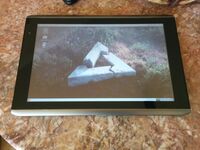Acer Iconia Tab A500 (acer-picasso)
 | |
| Manufacturer | Acer |
|---|---|
| Name | Iconia Tab A500 |
| Codename | acer-picasso |
| Released | 2011 |
| Hardware | |
| Chipset | Nvidia Tegra 2 T20 |
| CPU | Dual-core 1.0 GHz Cortex-A9 |
| GPU | ULP GeForce |
| Display | 800x1280 |
| Storage | 16/32 GB |
| Memory | 1 GB |
| Architecture | armv7 |
| Software | |
| Original software | Android 3.0 - 4.0 |
| postmarketOS | |
| Category | testing |
| Pre-built images | no |
| Mainline | yes |
| Flashing |
Works |
|---|---|
| USB Networking |
Works |
| Internal storage |
No data |
| SD card |
No data |
| Battery |
Works |
| Screen |
Works |
| Touchscreen |
Works |
| Multimedia | |
| 3D Acceleration |
No data |
| Audio |
Works |
| Camera |
No data |
| Camera Flash |
No data |
| Connectivity | |
| WiFi |
Works |
| Bluetooth |
Works |
| GPS |
No data |
| NFC |
No data |
| Modem | |
| Calls |
No data |
| SMS |
No data |
| Mobile data |
No data |
| Miscellaneous | |
| FDE |
No data |
| USB OTG |
No data |
| HDMI/DP |
No data |
| Sensors | |
| Accelerometer |
Works |
| Magnetometer |
No data |
| Ambient Light |
No data |
| Proximity |
No data |
| Hall Effect |
No data |
| Haptics |
No data |
| Barometer |
No data |
Contributors
- Worldblender
Maintainer(s)
- Worldblender
Users owning this device
- Arthurlutz (Notes: postmarketos installed)
- IonAgorria (Notes: Unknown)
How to enter flash mode (requires a custom bootloader)
See https://forum.xda-developers.com/iconia-a500/a500-2019-2020-t4039271 for a through explanation of how to go from stock to fully modded.
Installation
From https://forum.xda-developers.com/iconia-a500/linux-acer-iconia-tab-a500-2020-edition-t4136023: Check out the git repository at https://gitlab.com/Worldblender/pmaports, as this device is not yet included in upstream as of this writing. Switch to the branch 'device/acer-picasso'. This repository can also be added as a secondary remote if pmaports from upstream is already cloned.
Follow the Installation_guide as usual, where theses specifics have to be specified when requested:
- Vendor: acer
- Device code-name: picasso
- Kernel flavor: mainline
- Install non-free Wi-Fi + Bluetooth firmware: y
The user interface may be freely selected, as long as it is not one that requires 3D acceleration. To use KDE Plasma 5, add these lines to /etc/security/pam_env.conf:
QT_IM_MODULE=qtvirtualkeyboard QT_QUICK_BACKEND=software LIBGL_ALWAYS_SOFTWARE=1
Next, run the following commands in succession, after each one finishes, assuming the working directory contains the pmbootstrap.py script:
> ./pmbootstrap.py build device-acer-picasso
> ./pmbootstrap.py build firmware-acer-picasso
> ./pmbootstrap.py build linux-postmarketos-grate
From here on out, the generated chroot can be either installed to the eMMC, or a microSD card that must be inserted at or before boot time (the latter method allows for dual-booting Android already installed to the eMMC, although it can be directly accessed from the Linux system). The boot partition always has to be flashed to the eMMC in fastboot mode, as it is not possible to boot directly off of a microSD card. If installing to the eMMC, run
> ./pmbootstrap.py install
> ./pmbootstrap.py flasher flash_kernel --partition secboot
> ./pmbootstrap.py flasher flash_rootfs
(optional) > ./pmbootstrap.py flasher boot
If installing to a microSD card, run
> ./pmbootstrap.py install --sdcard [path to the device for installation]
> ./pmbootstrap.py flasher flash_kernel --partition secboot
Depending on what user interface was chosen earlier in the installation process, there may not be enough packages installed to get a fully-loaded GUI. Besides the built-in Wi-Fi, it is also possible to use a USB ethernet adapter, or connect to another computer with a micro-USB cable and get RNDIS access that enables using SSH to the tablet.
After installation to either a microSD card or the eMMC, the screen should look like: 